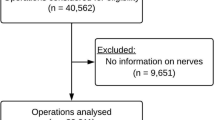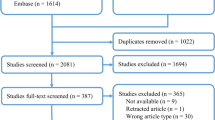Abstract
Background
Pain syndromes of somatic and neuropathic origin are considered to be the main causes of chronic pain after open inguinal hernia repair. Nerve-identification during open hernia repair is suggested to be associated with less postoperative chronic pain. The aim of this study was to define clinically relevant surgical anatomical zones facilitating efficient identification of the three inguinal nerves during open herniorrhaphy.
Method
Through dissection of 18 inguinal areas of embalmed and unembalmed human cadavers, identification zones were developed for the inguinal nerves (in particular for the genital branch of the genitofemoral nerve).
Results
The iliohypogastric nerve was identifiable running approximately horizontally and ventrally to the internal oblique muscle perforating the external oblique aponeurosis at a mean of 3.8 cm (range 2.5–5.5 cm) cranially from the external ring. When present, the ilioinguinal nerve was identifiable running ventrally and parallel to the spermatic cord, dorsally from the aponeurosis of the external oblique muscle. Identification of the genital branch of the genitofemoral nerve was more comprehensive. The course of the genital branch is laterocaudal at the level of the internal inguinal ring.
Conclusion
Based on the newly defined identification zones, peroperative identification of all inguinal nerves is possible. Further research is warranted to assess clinical feasibility of these zones and to evaluate the influence of (facultative) division, preservation or omittance of the identification of inguinal nerves on the incidence of chronic pain.




Similar content being viewed by others
References
National Medical Registration (LMR). Available at: http://www.prismant.nl/?pag=57 (Hospital statistics-procedures) Last visited: August 29, 2005 2004
Poobalan AS, Bruce J, Smith WC, et al. A review of chronic pain after inguinal herniorrhaphy. Clin J Pain 2003;19(1):48–54.
Cunningham J, Temple WJ, Mitchell P, et al. Cooperative hernia study. Pain in the postrepair patient. Ann Surg 1996;224(5):598–602.
Poobalan AS, Bruce J, King PM, et al. Chronic pain and quality of life following open inguinal hernia repair. Br J Surg 2001;88(8):1122–1126.
Alfieri S, Rotondi F, Di Giorgio A, et al. Influence of preservation versus division of ilioinguinal, iliohypogastric, and genital nerves during open mesh herniorrhaphy: prospective multicentric study of chronic pain. Ann Surg 2006;243(4):553–558.
Magee RK. Genitofemoral causalgia (a new syndrome). Can Med Assoc J 1942;46:326–329.
Lyon E. Genitofemoral causalgia (a new syndrome). Can Med Assoc J 1945;53:213–216.
Eckert P, Kaufer C. Das Ilio-Inguinalis-Syndrom. Chirurg 1974;45(1):44–45.
Laha RK, Rao S, Pidgeon CN, et al. Genito-femoral neuralgia. Surg Neurol 1977;8(4):280–282.
O’Brien MD. Genitofemoral neuropathy. Br Med J 1979;1(6170):1052.
Harms BA, DeHaas DR Jr, Starling JR. Diagnosis and management of genitofemoral neuralgia. Arch Surg 1984;119(3):339–341.
Starling JR, Harms BA, Schroeder ME, et al. Diagnosis and treatment of genitofemoral and ilioinguinal entrapment neuralgia. Surgery 1987;102(4):581–586
Starling JR, Harms BA. Diagnosis and treatment of genitofemoral and ilioinguinal neuralgia. World J Surg 1989;13(5):586–591.
Grosz CR. Iliohypogastric nerve injury. Am J Surg 1981;142(5):628.
Stulz P, Pfeiffer KM. Peripheral nerve injuries resulting from common surgical procedures in the lower portion of the abdomen. Arch Surg 1982;117(3):324–327.
Nahabedian MY, Dellon AL. Outcome of the operative management of nerve injuries in the ilioinguinal region. J Am Coll Surg 1997;184(3):265–268.
Tons C, Schumpelick V. The ramus genitalis syndrome following hernia repair. A clinical study concerning its preventability. Chirurg 1990;61(6):441–443.
Benini A. Die Ilioinguinalis- und Genitofemoralisneuralgie. Ursachen, Klinik, Therapie. Schweiz Rundsch Med Prax 1992;81(38):1114–1120.
Knockaert DC, Boonen AL, Bruyninckx FL, et al. Electromyographic findings in ilioinguinal-iliohypogastric nerve entrapment syndrome. Acta Clin Belg 1996;51(3):156–160.
Liszka TG, Dellon AL, Manson PN. Iliohypogastric nerve entrapment following abdominoplasty. Plast Reconstr Surg 1994;93(1):181–184.
Bower S, Moore BB, Weiss SM. Neuralgia after inguinal hernia repair. Am Surg 1996;62(8):664–667.
Amid PK. A 1-stage surgical treatment for postherniorrhaphy neuropathic pain: triple neurectomy and proximal end implantation without mobilization of the cord. Arch Surg 2002;137(1):100–104.
Ducic I, Dellon AL. Testicular pain after inguinal hernia repair: an approach to resection of the genital branch of genitofemoral nerve. J Am Coll Surg 2004;198(2):181–184.
Lee CH, Dellon AL. Surgical management of groin pain of neural origin. J Am Coll Surg 2000;191(2):137–142.
Kretschmer T, Antoniadis G, Borm W, et al. Latrogenic nerve injuries. I. Frequency distribution, new aspects, and timing of microsurgical treatment. Chirurg 2004;75(11):1104–1112.
Bueno J, Serralta A, Planells M, et al. Inguinodynia after two inguinal herniorrhaphy methods. Surg Laparosc Endosc Percutan Tech 2004;14(4):210–214.
Madura JA, Madura JA 2nd, Copper CM, et al. Inguinal neurectomy for inguinal nerve entrapment: an experience with 100 patients. Am J Surg 2005;189(3):283–287.
Ungeheuer E, Herrmann F. Complications following inguinal hernia surgery. Chirurg 1984;55(9):564–568.
Lichtenstein IL, Shulman AG, Amid PK, et al. Cause and prevention of postherniorrhaphy neuralgia: a proposed protocol for treatment. Am J Surg 1988;155(6):786–790.
Wantz GE. Complications of inguinal hernial repair. Surg Clin North Am 1984;64(2):287–298.
Amid PK. Lichtenstein tension-free hernioplasty: its inception, evolution, and principles. Hernia 2004;8(1):1–7.
Ravichandran D, Kalambe BG, Pain JA. Pilot randomized controlled study of preservation or division of ilioinguinal nerve in open mesh repair of inguinal hernia. Br J Surg 2000;87(9):1166–1167.
Picchio M, Palimento D, Attanasio U, et al. Randomized controlled trial of preservation or elective division of ilioinguinal nerve on open inguinal hernia repair with polypropylene mesh. Arch Surg 2004;139(7):755–758.
Dittrick GW, Ridl K, Kuhn JA, McCarty TM. et al Routine ilioinguinal nerve excision in inguinal hernia repairs. Am J Surg 2004;188(6):736–740.
Izard G, Gailleton R, Randrianasolo S, Houry R. Treatment of inguinal hernias by Mc Vay’s technique. Apropos of 1332 cases. Ann Chir 1996;50(9):755–766
The ‘Inguinal Hernia’ guideline of the Association of Surgeons of the Netherlands (NVvH). In: Van Zuiden Communications B.V.; 2003;30
Moosman DA, Oelrich TM. Prevention of accidental trauma to the ilioinguinal nerve during inguinal herniorrhaphy. Am J Surg 1977;133(2):146–148.
Oelrich TM, Moosman DA. The aberrant course of the cutaneous component of the ilioinguinal nerve. Anat Rec 1977;189(2):233–236.
Papadopoulos NJ, Katritsis ED. Some observations on the course and relations of the iliohypogastric and ilioinguinal nerves (based on 348 specimens). Anat Anz 1981;149(4):357–364.
Mandelkow H, Loeweneck H. The iliohypogastric and ilioinguinal nerves. Distribution in the abdominal wall, danger areas in surgical incisions in the inguinal and pubic regions and reflected visceral pain in their dermatomes. Surg Radiol Anat 1988;10(2):145–149.
Chevallier JM, Wind P, Lassau JP. La blessure des nerfs inguino-fémoraux dans les cures de hernie. Un danger anatomique des techniques traditionnelles et laparoscopiques. Ann Chir 1996;50(9):767–775.
Akita K, Niga S, Yamato Y, et al. Anatomic basis of chronic groin pain with special reference to sports hernia. Surg Radiol Anat 1999;21(1):1–5
Diop M, Dia A, Ndiaye A, et al. Emergence et trajet du nerf ilio-inguinal a l’aine. Morphologie 2000;84(266):29–32.
Liu WC, Chen TH, Shyu JF, et al. Applied anatomy of the genital branch of the genitofemoral nerve in open inguinal herniorrhaphy. Eur J Surg 2002;168(3):145–149.
Al-dabbagh AK. Anatomical variations of the inguinal nerves and risks of injury in 110 hernia repairs. Surg Radiol Anat 2002;24(2):102–107.
Rab M, Ebmer J, Dellon AL. Anatomic variability of the ilioinguinal and genitofemoral nerve: implications for the treatment of groin pain. Plast Reconstr Surg 2001;108(6):1618–1623
Jacobs CJ, Steyn WH, Boon JM. Segmental nerve damage during a McBurney’s incision: a cadaveric study. Surg Radiol Anat 2004;26(1):66–69.
Whiteside JL, Barber MD, Walters MD, et al. Anatomy of ilioinguinal and iliohypogastric nerves in relation to trocar placement and low transverse incisions. Am J Obstet Gynecol 2003;189(6):1574–1578; discussion 1578
Final appraisal determination: Laparoscopic surgery for inguinal hernia repair. In: National Institute for Clinical Excellence: http://www.nice.org.uk/pdf/FAD_Laphernia_ review_2004.pdf Last visited 19/12/2005
Lytle WJ. Genitofemoral neuropathy. Br Med J 1979;1(6176):1491
Amid PK. Groin hernia repair: open techniques. World J Surg 2005;29(8):1046–1051.
Acknowledgements
The authors thank Dr. J.C. den Hollander of the Department of Pathology for assistance with the production of the histological images.
Author information
Authors and Affiliations
Corresponding author
Rights and permissions
About this article
Cite this article
Wijsmuller, A.R., Lange, J.F.M., Kleinrensink, G.J. et al. Nerve-Identifying Inguinal Hernia Repair: A Surgical Anatomical Study. World J. Surg. 31, 414–420 (2007). https://doi.org/10.1007/s00268-006-0376-y
Published:
Issue Date:
DOI: https://doi.org/10.1007/s00268-006-0376-y




